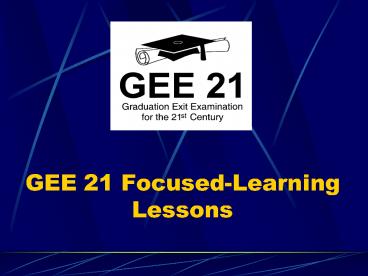GEE 21 FocusedLearning Lessons PowerPoint PPT Presentation
1 / 38
Title: GEE 21 FocusedLearning Lessons
1
GEE 21 Focused-Learning Lessons
2
Whats it all about?
3
Support
4
Remediation Policy8th Grader who scores
Unsatisfactory
- District must offer 50 hours of summer remediation
5
Remediation Class for Option 1 and Option 2
Students
- Focus on 8th Grade LEAP 21
- Elective credit possible
6
High School Remediation Course
- For students promoted to the 9th grade without
having passed either the ELA or math 8th grade
LEAP 21 - Focus preparing students for high school level
math or English courses - Students MUST pass this course before enrolling
in required math or ELA courses.
7
GEE 21 Remediation
- Students who score Unsatisfactory shall be
provided remediation. - Districts decide the type and length.
8
Focused-Learning LessonsPurpose and Structure
9
Purpose
- Develop conceptual understanding
- Focus on missed learning
- Practice skills
- Build competency
10
Structure
- Assessment Component
- Translating Standards into Instruction
- Sources of Evidence of Student Learning
- Attributes of Student Work at the Got It Level
- GEE 21 Connection
- Recommended Materials/References
11
Structure
- Assessment Component
- English Language Arts
- Reading and Responding
- Composition/Proofreading
- Using Information Resources
- Math
- Strands
- Standards and Benchmarks
- Focus of Lesson
12
Structure
- Translating Standards into Instruction
- Specific instructional strategies
- Examples
- Models
13
Structure
- Sources of Evidence of Student Learning
- Anecdotal data
- Individual assignments
- Problem solving/critical thinking
- Group work
- Peer coaching/editing
14
Attributes of Students at the Got It Level
(Content-Specific)
- Recognizes the concept
- Applies the concept
- Extends the concept
15
Structure
- GEE 21 Connection
- Alignment to Teachers Guide to Statewide
Assessment - References to released items
- Links to assessment practices
16
Structure
- Recommended materials/references
- Texts
- Online sources
- Technology
- Handouts/Blackline Masters
- Teacher Reference Sources
17
Mathematics Lessons
- Focus of mathematics standards
- ALL students
- doing meaningful mathematics
- using appropriate tools.
18
Strands
19
Acknowledgements
20
Number and Number RelationsLesson 1 Fractions,
Decimals and Percents
- Selected Content Standards
- Benchmarks Assessed
- Specific focus for the lesson
- Skills listed in the Teachers Guide
- Translating Content Standards into Instruction
- Teaching strategies focus on conceptual
understanding - Teacher Blacklines and Student Worksheets
- Sources of Evidence of Student Learning
- Sample test items similar to GEE 21
- Attributes of Student Work
21
AlgebraLesson 4 Solving and Graphing Linear
Equations
- Use of questions
- Connections between problem situation, equation,
and graph - Good contextual problems
22
Measurement and Geometry
- Measurement lessons focus on hands-on
activities - Concepts of perimeter, area, volume, etc.
- Size of units
- Use of correct units
- Geometry lessons focus on key concepts
- Properties of figures
- Pythagorean theorem
- Transformational geometry
23
Data Analysis, Probability and Discrete Math
- Constructing and using different types of charts
and graphs - Measures of central tendency
- Two-variable data
- Probability
- Organizing information tree diagrams, Venn
diagrams, counting techniques - Making Inferences
24
Patterns, Relations and Functions
- Understanding patterns in lists, graphs, and
tables - Linear Functions
- Rate of change
- Linear regression
- Translations of linear functions
- Parameters of real-life linear functions
25
Overlapping Topics in Lessons
- Tables
- Graphing
- Graphing and solving linear equations included in
Algebra Patterns and functions - Interpretation of graphs in three strands
- Problem-Solving and Analysis
- Number Lesson 4
- Geometry Lesson 6
- Data Lesson 8
26
Using the Focused-Learning Lessons
- Analyze student scores
- Be familiar with the lessons
- Decide which lessons to teach and when
- Integrate these lessons with other resources
using your own teaching strategies
27
An Instructional Model for Solving Contextual
Mathematics Problems
- Four steps to solving mathematics problems
- For each step
- Student actions
- Skills used by the student
- Instructional intervention strategies
28
English Language Arts
- Focused-Learning Lessons
29
Acknowledgements
30
Reading and Responding
- 20 Lessons
- Poetry
- Short Story
- Nonfiction
31
Compostion/Proofreading
- 10 lessons
- Brainstorming, clustering
- Paragraph development
- Multi-paragraph compositions
- Mechanics
- Sentence structure
32
Lesson Focus Punctuation
- Students will develop a basic understanding of
the accurate use of punctuation marks in
sentences and paragraphs to convey meaning.
33
- You may be one of those people who has problems
with words such as two too and to and and but
both conjunctions are easy to correct when you
learn the simple rules in the usage of each
although you may find it is easier to replace the
word with a less confusing term some words cannot
be substituted
34
You may be one of those students who has problems
with words such as two, too, and to. And and but,
both conjunctions, are easy to correct when you
learn the simple rules in the usage of each.
Although you may find it is easier to replace the
word with a less confusing term, some words
cannot be substituted.
35
Using Information Resouces
- Outlining
- Topic sentence
- Organizational skills
- Graphic organizers
- Bibliographical entries
- Parenthetical citations
- Works Cited Page
- Table of Contents/Index
- Internet Sources
36
Sample Guiding Questions
- What is the purpose of the Works Cited page?
- How are entries listed?
- How is the authors name listed?
- How are titles of books and periodicals treated?
- Where are periods placed?
37
Works Cited
- Apply format used in a model into an original
works cited page
38
Contact Information
- Nancy Beben
- Mathematics Program Coordinator
- Nbeben_at_doe.state.la.us
- Taylor Powers
- English Program Coordinator
- Etpowers_at_doe.state.la.us
- www.louisianaschools.net

